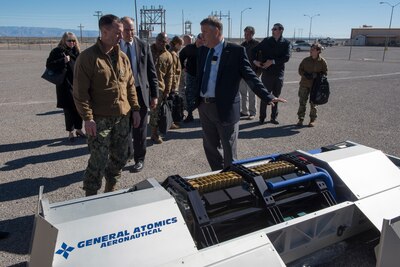By Marine Corps Sgt. David Staten DoD News, Defense Media
Activity
WASHINGTON, March 21, 2018 — As stated in the National
Defense Strategy, the United States needs to invest and accelerate the
modernization of key capabilities to build a more lethal force.
Michael D. Griffin, the undersecretary of defense for research
and engineering, today spoke to more than 500 senior leaders from the U.S.
government and defense industry to explore the impact of integrating directed
energy capabilities into the national security enterprise at the 2018 Directed
Energy Summit at the Ronald Reagan Building and International Trade Center
here.
Directed energy weapon systems employ lasers, microwaves and
particle beams against enemy targets.
Griffin has been in this arena since the 1980s and worked
for the first three directors of the original missile defense agency.
“Directed energy was then in our view an important part of
our future portfolio because only directed energy could offer the kind of
extended magazine, if you will, the extended range, speed of light delivery of
the kill,” Griffin said. “It was the only way that in the long run you could
see yourself competing with the threat and coming out on top.”
Directed energy has gone through a lot of evolutions over
the years, Griffin added.
For many years, he said, the Congress and national policy
fundamentally did not support the development of directed energy as a
warfighting tool.
“So I think that has changed,” he said. “When I have
discussions on the Hill, there is very much -- a lean-forward posture now.”
China is flexing its muscles in the Indo-Pacific region and
Russia is resurgent, Griffin told the audience.
“You don't build islands in the South China Sea and
militarized them with benign intentions,” he said. “You don't get on TV and
brag about your 4,000-mile intercontinental hypersonic nuclear delivery system
with benign intentions.”
Superpower Competition
Griffin said there’s a recognition that superpower
competition is again on the rise, and the United States must modernize its
military if it wants to maintain its position of global preeminence.
“We will not win in a man-to-man fight,” Griffin said. “We
have to have the technological leverage. That realization was responsible for
the creation of my office, to elevate the role of technology maturation and
deployment and I believe it is responsible for the renewed interest in directed
energy weapons.”
And, directed energy is more than big lasers, the
undersecretary said.
The undersecretary asked his audience to consider directed
energy systems such as high-power microwaves, different laser designs and
particle beam weapons.
“Each of these systems has its own advantages and each has
its own disadvantages,” he said. “We should not lose our way as we come out of
the slough of despondence in directed energy into an environment that is more
welcoming of our contributions. We should not lose our way with some of the
other technologies that were pioneered in the ’80s and early-’90s and now stand
available for renewed effort.”
In his capacity as undersecretary for research and
engineering, Griffin said he is going to be very welcoming of other approaches
that may not have had a lot of focus in recent years or decades.
Directed Energy Venues
There are four venues, he said, in which directed energy can
serve: land, air, sea and space.
He urged the audience to not forget that because the
technologies are fundamental and can be applied across those domains, all of
which are important to them.
The basing strategies, the warfighting tactics, techniques,
procedures, the logistics support requirements, the manpower that is needed for
support, all of these things are different and are required to be different
because of the different venues in which they will have to operate, he added.
“I would urge us not to think that one size fits all,”
Griffin said. “I would urge us not to think that there can be a lead service
for directed energy. I would urge us to not willow the competition down too
quickly. I would urge us to keep a lot of arrows in our quiver as we go forward
figuring out how we're going to translate directed energy technologies into
warfighting systems that are going to defend this country and our allies.”
America should also take advantage of the brain power that
traditional U.S. allies and partners can offer in the development of these
technologies so they can be developed together, the undersecretary said.
“The United States will always be stronger for its
alliances, he said.
Griffin told a story about when he worked for NASA during
the Reagan administration. He had the opportunity as the administrator of NASA
to become familiar in great detail with the 14-nation partnership that put the
international space station together. At first he was suspicious of the
partnership but later understood how misguided he was.
“I came to believe that we got much more out of the
international collaboration on the space station than we ever gave up in terms
of revealing of our own capabilities and technologies,” the undersecretary
said.
“The way to technical superiority is to run faster and work
harder and not to try to wall off our own capabilities,” Griffin said. “So, as
we explore directed energy technologies, where there are opportunities, I will
be looking for careful and measured but still very real cooperation with our
allies and partners. I think in the long run that will benefit us.”








No comments:
Post a Comment